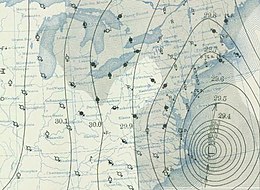Great 1938 Hurricane
| Category 5 major hurricane (SSHWS/NWS) | |

Weather map from September 21 depicting the storm off the Mid-Atlantic coast
|
|
| Formed | September 9, 1938 |
|---|---|
| Dissipated | September 23, 1938 |
| (Extratropical after September 22) | |
| Highest winds |
1-minute sustained: 160 mph (260 km/h) |
| Lowest pressure | < 940 mbar (hPa); 27.76 inHg |
| Fatalities | 682 to 800 direct |
| Damage | $306 million (1938 USD) |
| Areas affected | Southeastern United States, Northeastern United States (particularly Connecticut, New York, Rhode Island, and Massachusetts), southwestern Quebec |
| Part of the 1938 Atlantic hurricane season | |
The 1938 New England Hurricane (also referred to as the Great New England Hurricane and Long Island Express) was one of the deadliest and most destructive tropical cyclones to impact New England. The storm formed near the coast of Africa on September 9, becoming a Category 5 hurricane on the Saffir-Simpson Hurricane Scale before making landfall as a Category 3 hurricane on Long Island on September 21. The hurricane was estimated to have killed 682 people, damaged or destroyed over 57,000 homes, and caused property losses estimated at US$306 million ($4.7 billion in 2017). Even as late as 1951, damaged trees and buildings were still seen in the affected areas. It remains the most powerful and deadliest hurricane in recent New England history, eclipsed in landfall intensity perhaps only by the Great Colonial Hurricane of 1635. It was only the third hurricane to strike New England since 1635.
The storm was first analyzed by ship data south of the Cape Verde Islands on September 9. Over the next ten days, it steadily gathered strength and slowly tracked to the west-northwest. By September 20, while centered east of the Bahamas, the hurricane is estimated to have reached Category 5 intensity. In response to a deep trough over Appalachia, the hurricane veered northward, sparing the Bahamas, Florida, the Carolinas, and the Mid-Atlantic. At the same time, a high pressure system was centered north of Bermuda, preventing the hurricane from making an eastward turn out to sea. Thus, the hurricane was effectively squeezed to the north between the two weather systems.
Late on September 20, this set-up caused the storm's forward speed to increase substantially, ultimately reaching 70 mph, the highest forward velocity ever recorded in the annals of hurricanes. This extreme forward motion, being in the same general direction as the winds on the eastern side of the storm as it proceeded north, caused the perceived wind speed in areas east of the eye to be far higher than would be the case with a hurricane of more typical forward speed. (Winds rotate counter-clockwise around all low pressure systems in the Northern Hemisphere, thus winds on the right side of a hurricane, "right" being relative to the direction of motion of the storm itself, are moving in the same general direction as the hurricane. Therefore, the forward motion increases the observed wind speed for points to the right of the eye of the hurricane and decreases the observed wind speed for points to the left of the eye, but in a complex way that defies crude addition or subtraction of the forward motion from the "intrinsic" wind speed of the hurricane.) During the early hours of September 21, the storm, centered several hundred miles to the southeast of Cape Hatteras, weakened slightly. By 8:30 am EDT, the hurricane was centered approximately 100 miles (160 km) due east of Cape Hatteras, and its forward speed had increased to well over 50 mph. This rapid movement did not give the hurricane a sufficient amount of time to weaken over the cooler waters before it reached Long Island. During the 9:00 am EDT hour, the hurricane sped through the Virginia tidewater. Between 12:00 pm and 2:00 pm EDT, the New Jersey coastline and New York City caught the western edge of the hurricane. At the same time, weather conditions began to deteriorate rapidly on Long Island as well as along the southern New England coast. The hurricane made landfall at Bellport on Long Island's Suffolk County sometime between 2:10 pm and 2:40 pm EDT as a category 3 hurricane with sustained winds of 120 mph. The storm made a second landfall still as a category 3 hurricane somewhere between Bridgeport and New Haven, Connecticut, around 4:00 pm with sustained winds of 115 mph.
...
Wikipedia
